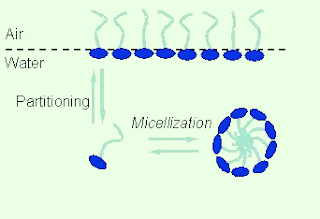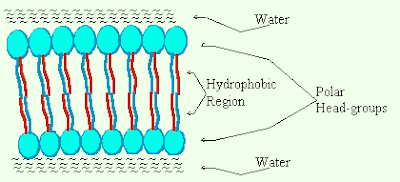Lecithin is the most common phospholipid in human bodies.
- one glycerol molecule
- two fatty acids molecules
- one phosphoric acid molecule
 |
| Structure and symbol of a phospholipid molecule |
2. Phospholipid is a major component of cell membrane and hence is distributed all over the body of an organism.
- A phospholipid molecule consists of one glycerol molecule attached to two fatty acids chain and one phosphate group.
- Additional small molecules (usually polar) can be linked to the phosphate group to form a variety of different phospholipids.
- For instance, choline molecule attaches to the phosphate group of phospholipids to form lecithin. Lecithin is the most common phospholipid in human bodies. The major phospholipids of cell membrane is lecithin. The fatty acids of lecithin is oleic acid (unsaturated) and stearic acid (saturated).
- The hydrophilic head of phospholipid molecules is soluble in water, while the hydrophobic tail is insoluble in water.
- In water, phospholipid molecules assemble into a droplet called micelle. On the surface of water, phospholipid molecules are assemble closely with hydrophilic heads dissolved in water and the tails jutting out of the surface.

Assembly of phospholipid molecules on the water surface and in water - In cells, both the intracellular environment and the immediate external environment are water. This causes phospholipids to form bilayer. In this bilayer, the hydrophilic heads are on the outside (in contact with water); the tails of phospholipids point to the interior. This bilayer is the main structures in the formation of cell membrane.

Cross section of a phospholipids bilayer
- Phospholipids are the main structural components for cell membranes.
- Phospholipid such as lecithin is involved in the production of neurotransmitters such as acetylcoline in the neurons.
- Phospholipid molecules are usually involved in transporting fat in the body.
http://sevendaysperweek.blogspot.ca/2015/09/stpm-biology-biological-molecules-part_25.html
Oleic acid is a monounsaturated fatty acid found naturally in many plant sources and animal products. It is an omega-9 fatty acid, and as such is considered one of the healthier sources of fat in the diet. Health experts often recommend using it in cooking, and a number of so-called health foods and diet products will use this compound in place of animal fats.
Where It’s Found
One of the chief sources of this acid in foods is olive oil. Whole olives also contain the compound, but typically only in trace amounts. When pressed and drained together, however, the olives’ acid levels are combined, leading to high concentrations in most cases. Canola and grapeseed oil also contain oleic acid.
Many nuts and seeds contain the fat as well, and it can also also be found readily in most poultry, particularly chicken and turkey. Isolating it from animal sources is often somewhat challenging, however. While vegetables and nuts usually contain oleic acid as the primary fat, most meats contain a combination of both saturated and monounsaturated elements.






